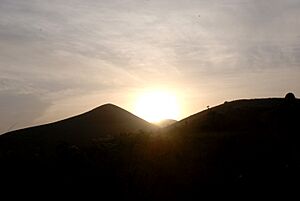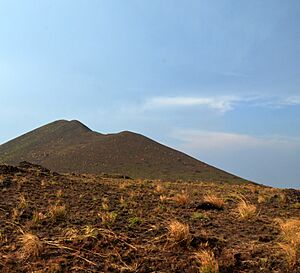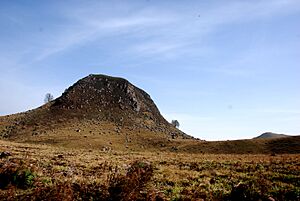Cameroon climbing mouse facts for kids
Quick facts for kids Cameroon climbing mouse |
|
|---|---|
| Conservation status | |
| Scientific classification |
The Cameroon climbing mouse (scientific name: Dendromus oreas) is a small rodent. It belongs to the Nesomyidae family. This special mouse lives only in the high grasslands. You can find it on three mountains in Cameroon.
Contents
What Does It Look Like?
The Cameroon climbing mouse is quite small. It has a long tail. You might notice a faint black stripe along its back. Its fur on the back is brown. The fur on its belly can be dark reddish-brown. It can also be a light yellowish-grey.
This mouse has white or cream spots. These spots are on its throat and chin. They are also found near its tail. Its ears are dark, almost black. They have fine, light brown hairs. There is a pale spot at the base of each ear. The back feet have five toes. The fifth toe has a claw. It can move this toe like a thumb. This helps it grip things.
Where Does It Live?
This mouse is found only in Cameroon, a country in Africa. It lives on three specific mountains.
- Mount Cameroon: Here, it lives at very high altitudes. This is from about 1,700 to 4,000 meters up.
- Mount Manenguba: On this mountain, it lives between 1,800 and 1,900 meters high.
- Mount Kupe: You can find it around 850 meters on Mount Kupe.
What Kind of Home Does It Like?
The Cameroon climbing mouse prefers high mountain grasslands. These are often above the tree line. On Mount Cameroon, it lives among large rocks. On Mount Manenguba, it likes grassy bushes. On Mount Kupe, it can even live in farms and plantations. It does not like the thick forests. These forests are found at lower parts of the mountains.
How Does It Behave?
The Cameroon climbing mouse is active both day and night. This means it is diurnal and nocturnal. Even though its name says "climbing," it mostly lives on the ground. It digs burrows into the soil. However, it is still very good at climbing when it needs to.
What Threats Does It Face?
The Cameroon climbing mouse faces some dangers. One big threat is Climate change. As the climate changes, bushes and trees might grow higher up the mountains. This could shrink the mouse's living space. Also, if forests at lower levels are cut down, farm animals might move higher up. These animals could then graze where the mouse lives. This would also reduce its habitat.





